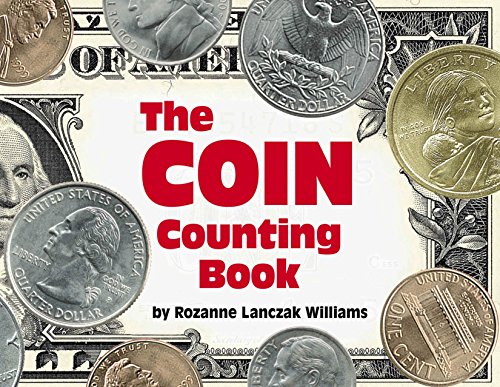On this page: Learn & Practice | Manipulatives | Picture Books
learn & practice
✏️ My First Book of Money: Counting Coins and My Book of Money: Dollars and Cents by Rozanne Lanczak Williams. These two Kumon workbooks offer plenty of extra practice for kids who are learning to add up different denominations of currency. – Elementary
✏️ Money worksheets from MathFactCafe. Use this free website to generate printable money problem worksheets. You can tailor the worksheets by selecting the problem type (find the total value, count the coins, find the missing coin), the types of coins (penny, nickel, dime, quarter, and half dollar), and problem difficulty.
✏️ Khan Academy math modules. Khan Academy offers a wealth of free math educational resources, including a large library of instructional videos and online practice problem sets.
Tip – On Khan Academy, the Money modules are divided by grade. Grade 2 provides practice counting combinations of dollars and coins. Grade 4 includes money conversion word problems.
✏️ Money module from CK12. CK12 offers free, adaptive online practice across all areas of math. In the Money module, practice recognizing, counting, and comparing money. Perform arithmetic operations with money. – Elementary
🔗 Content Connection: World History. Explore the history of money.
manipulatives
🖐️ Play Money. Real coins can be used for practicing counting and exchanging money, but if you'd rather not teach using real currency, then inexpensive sets of play money can be purchased online. Of course, pretend money is also fun to have around for all kinds of imaginative play. – Preschool • Elementary
picture books
Picture books are a fun, low-stress way to introduce new mathematical concepts.
📖 The Coin Counting Book by Rozanne Lanczak Williams. “One penny, two pennies, three pennies, four. What will we get when we add one more?” Here is a very visual explanation of the relative values of different sets of coins. It's a simple yet effective tool for learning to identify and count coins. Perfect for early elementary. – Elementary
📖 Follow the Money by Loreen Leedy. In this funny and information-packed picture book, we follow George, a newly minted quarter, as he leaves the bank and passes through many hands before winding up back at the bank. Along the way, children are introduced to the various denominations of currency and have the opportunity to practice adding money and calculating change. A great supplemental resource for young elementary students. – Elementary
📖 The Go-Around Dollar by Barbara Johnston Adams. Here, we follow a dollar bill as it passes hands from owner to owner. It's a quick read, and additional text on each page gives interesting facts about currency. – Elementary
📖 Alexander, Who Used to be Rich Last Sunday by Judith Viorst. Poor Alexander has some serious money management issues. Alexander is a very relatable protagonist, and this book can be used as a fun literature link during a unit on money. – Preschool • Elementary
📖 If You Made a Million by David Schwartz. “Have you ever wanted to make a million dollars? Marvelosissimo the Mathematical Magician is ready, willing, and able to explain the nuts and bolts—as well as the mystery and wonder—of earning money, investing it, accruing dividends and interest, and watching savings grow." Highly recommended. – Elementary












